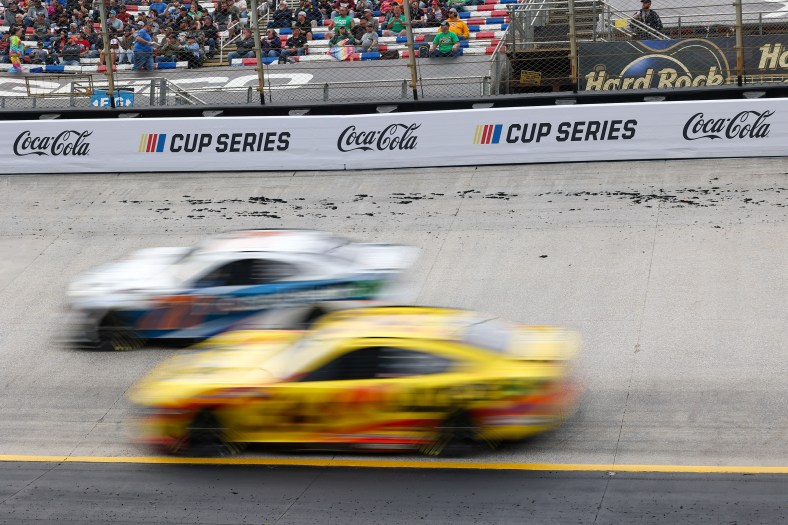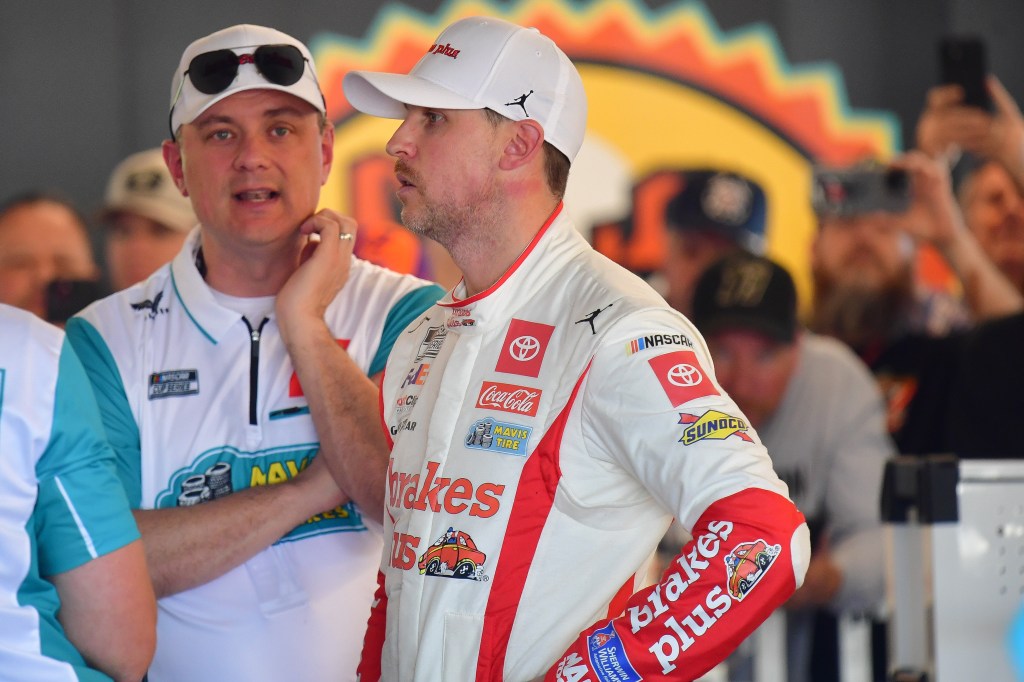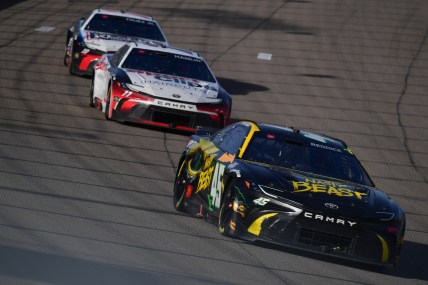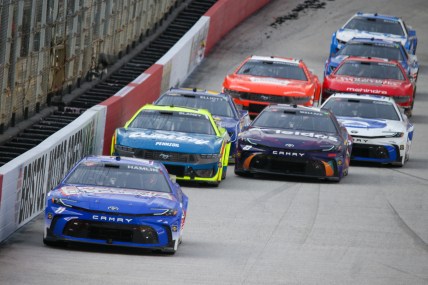
We’ll likely never see that again but hopefully we’ll see more like it.
The Food City 500 was the result of a once in a lifetime set of circumstances that produced a race that could not be duplicated, even if NASCAR really wanted it. And honestly, as much as everyone enjoyed the race, it’s not aspirational even if there are elements worth pursuing moving forward.
This was such a welcome accident.
And really, that’s the biggest takeaway from the weekend, that the NASCAR industry backed into something that forced conversations that could lead to directions for everyone to pursue.
First, the superlatives, because the race produced 54 lead changes across 16 different drivers. It was the most lead changes ever recorded for a track less than a mile and the first time a since August 1981 that a non-superspeedway surpassed 50 lead changes.
It was the result of a borderline disastrous amount of tire degradation that teetered drastically close to the edge but never crossed over.
The modern Cup Series, for better and worse, is about running as hard as you can for as long as you can. It is a far removal from the vast history of the sport, one that required finesse, because if drivers didn’t manage their tire wear, they wouldn’t make it to the end.
It’s a rapidly vanishing skill set.
Really, this is a feature and bug of the past decade, as some of the longest tenured drivers like 2012 champion Brad Keselowski and race winner Denny Hamlin said forced them to flex muscles at this level they hadn’t used in a long time.
“This is the first time the driver played a huge role in a long, long time,” Hamlin said. “A long time. It’s a different philosophy from what we’re used to, which is everyone is just kind of on the gas all the time running the bottom, the shortest way around.
“Technique was a huge deal today.”
Keselowski, the day before, had waxed poetic about discipline and how the Cup Series no longer required the sort of diligence behind the wheel that was previously required.
“There was a lot of discipline required and it was a fun race, to be honest, because you just had to be so smart behind the wheel,” Keselowski said. “It would bite you in a heartbeat and you had to have a good setup.”
Josh Berry, who spent an entire adult lifetime racing like this in Late Model Stock Cars, said Sunday was a ‘shit show’ but also ‘I’m not going to lie, it was kind of fun.’
The Food City 500, with its return to concrete after three years of dirt racing combined with the red and white Winston era walls, was a true throwback beyond its aesthetics. This is part of racing that NASCAR has increasingly gotten away from.
And that’s really the conversation we all need to have this week.
It’s not any different than the conversation the industry has been forced to have this winter over horsepower levels, but there are also multiple ways to legitimately produce a scaled version of what happened on Sunday at every short track on the schedule.
“Yeah, we didn’t need any more horsepower today,” Hamlin said.
But really, Sunday was a proof of concept of what that conversation is really about, which is just creating speed disparity through the field. Drivers have been clamoring for more horsepower, especially on short tracks and road courses, because that will challenge them to drive deeper into the corner than those they are chasing.
It will force mistakes in an era defined by its spec car and extreme parity.
But also, drivers believe more power will blow the back tires off and create tire wear that has been missing for over a decade too. When tires wear, even by accident on Sunday, it creates speed disparity through the field and forces the drivers to have to make split second decisions in traffic.
“It is about off-throttle time,” Hamlin said. “When you have off-throttle time, that is an opportunity for me to drive in deeper than the other guy and make a pass. When we’re all matting it, driving all the way till we get to the corner, there’s no off-throttle time, there’s just no passing.
“Today was seconds of falloff. It was incredible. I certainly wasn’t believing what I was seeing.”

It forced crew chiefs to have to burn their calculators and make decisions based on the tire management executed by their drivers. As much fun as it was for Hamlin, crew chief Chris Gabehart really enjoyed the challenge on Sunday too.
He enjoyed it as a race fan too.
“I’m telling you, I was thinking about a hundred laps into the race, when is the last time 18-second lap times were run with a Cup car at Bristol,” Gabehart said. “I can’t pinpoint it. Except the picture over there on the wall. I bet that was the last time a Cup car ran 18 seconds around Bristol, which is great. It provides so much opportunity for these guys to make it work or screw it up.”
Which brings us to what has to come next.
In real time, Goodyear racing tires director Greg Stucker indicated that his team somehow screwed up with the compound they brought to the track, because be it the cooler temperatures or a track that used resin instead of PJ1 TrackBite as the traction compound of choice, they hadn’t done their homework.
Drivers and crew chiefs were near universal in pushing back and saying this accident was a Bob Ross happy little accident.
No, this extreme of tire wear isn’t sustainable but what if the degradation from Sunday could be replicated and dialed back? Maybe Goodyear doesn’t even have to do a thing because teams already started to figure it out.
Tire runs that were barely lasted 40 laps in the first stage were lasting upwards of 70 by the end of the race. The teams made the adjustment so Goodyear knee-jerking ahead of the Bristol Night Race in September would only make the racing worse.
So Gabehart and Hamlin pleaded with fans and the industry to not take Goodyear to task. It was an accident but it was actually a directionally positive end result.
“In my opinion, the sport needs to learn from this,” Gabehart said. “Again, I’ve been saying this for a while anytime anyone asks but we have to stop talking badly about Goodyear in these situations.
“This is not bad. Goodyear can make a tire that last a million miles on my car when I get back home. It’s fantastic.
“But this is supposed to be sport. It’s supposed to be hard. It’s supposed to force these guys to make decisions in the car. Do I go now? Do I not? The crew chiefs to make decisions on how they treat the tire, what their setup is, how long do you want to run this stint. You can’t just run the fuel tank out and the tire not blow. It might blow on you.”
He is saying we need more of this, not less.
We got to this point because teams push the limits of the tires, and when they resultingly fail, people across the entire spectrum pile on Goodyear and they respond by building even more forgiving tires and the racing has suffered as a result.
If you think Gabehart is only saying this thing that he has actually said for a decade because he won on Sunday, take it from rival crew chief Cliff Daniels instead.
“Could you have this every week, no,” Daniels said. “I don’t think anyone would be comfortable having this every week, but to your point, was it nice to have different variables that changed the racing a lot. Yes.”
It was an emphatic yes.
“It was fun, it was refreshing. We were talking and thinking and all these things about what to do. It had an old school feel to it. It was fun to be a part of it.”
And so, maybe we can’t do this every week or even every short track race, but we can go directionally further this direction. It was an accident but Goodyear and NASCAR learned, that especially in a spec car era, that if you give teams another variable to work through, good things happen.
Be it horsepower, a narrower tire or tires that simply fall off closer to what they did over a decade ago, NASCAR is better when races are not hammer down, 100 percent qualifying laps for an entire race.
We can have more like this.
Matt Weaver is a Motorsports Insider for Sportsnaut. Follow him on Twitter.

